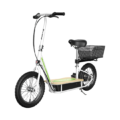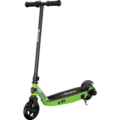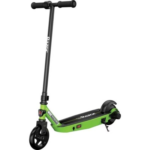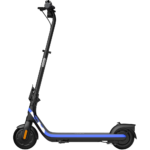- Home
- Scooters
- Electric Scooters
- Razor Black Label E100
Razor Black Label E100
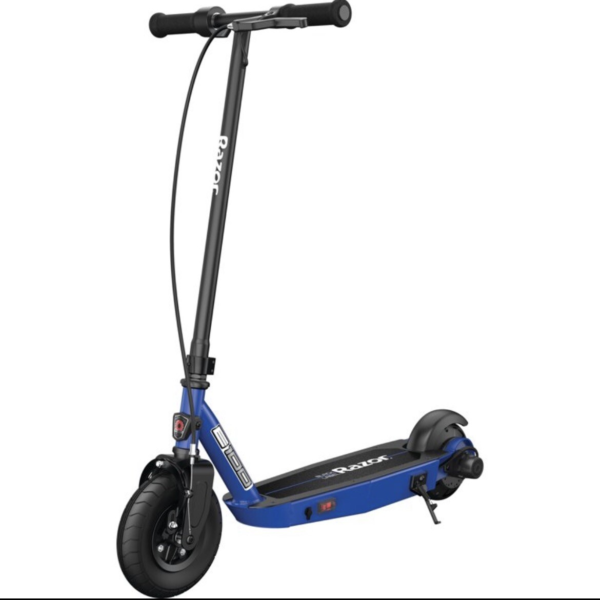

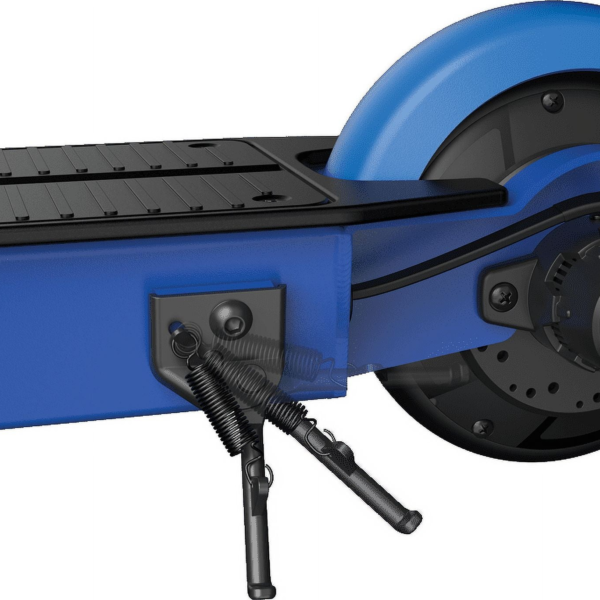
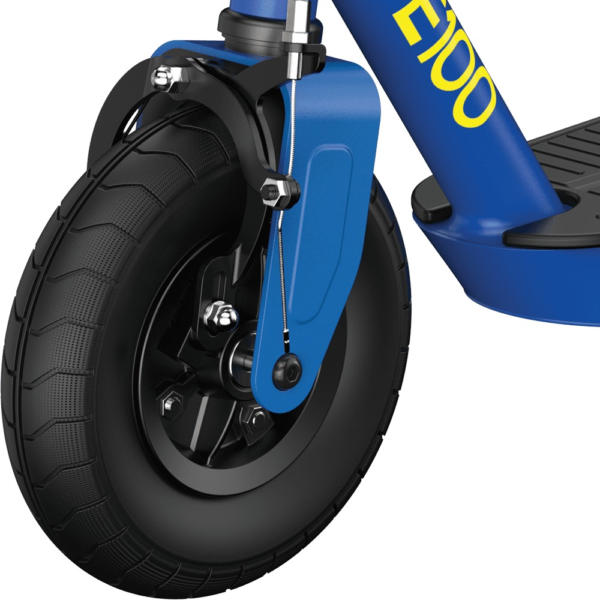
- Battery Range: 10 mi (16 km)
- Top Speed: 10 mph (16 km/h)
- Motor Power: 100 W nominal
- Weight Capacity: 120 lb (54 kg)
- Charging Time: ~6–8 h
- Scooter Weight: 26.0 lb (11.8 kg)
PROS
- Classic E100 feel, modern look
- Kid-friendly 10 mph cap
- Low-upkeep Power Core hub
- Solid tires resist punctures
- Stable, low deck stance
CONS
- Not for adult riders
- Shorter range
- No suspension
- Lower weight capacity

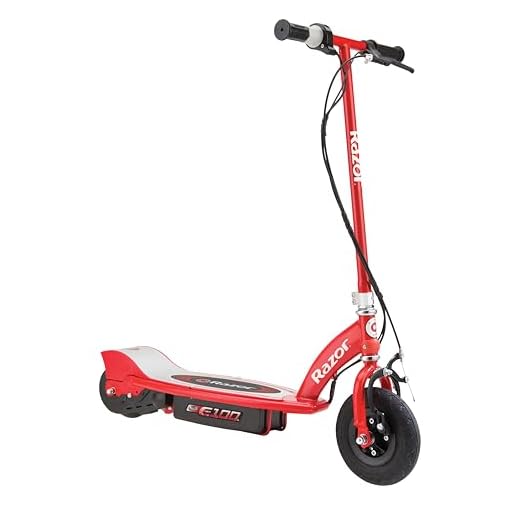
Table of contents
- What Is the Razor Black Label E100?
- How the Razor Black Label E100 Works
- Key Specifications
- Design & Build Quality
- Performance Fundamentals
- Battery, Range & Efficiency
- Ride Quality & Comfort
- Braking & Safety Features
- Portability & Daily Usability
- Maintenance & Care
- Weather & Seasonal Considerations
- Razor Black Label E100 vs Alternatives
- Who the Razor Black Label E100 Is (and Isn’t) For
- FAQs
- Glossary
- Closing Thoughts
The Razor Black Label E100 is a kick-to-start, single-speed electric scooter built for young riders who need stability and simple controls. Consequently, it favors predictable handling over raw speed, which supports skill-building and safe practice. For families comparing models, the standard Razor E100 provides a useful reference point, yet the Black Label trim adds a sportier look while keeping the same straightforward behavior. If you want a first scooter that’s easy to explain and supervise, this model fits the brief.
What Is the Razor Black Label E100?
The Black Label E100 sits in Razor’s youth lineup as a tough, no-frills scooter with a steel frame, a front pneumatic tire, and a durable rear urethane wheel. Additionally, it uses a chain-driven motor and a sealed lead-acid battery pack, both of which have a long track record in kid-friendly scooters. The look is sportier than the standard E100, yet the mission remains the same: keep things approachable and consistent.
Because the platform targets riders who are still building skills, the hardware emphasizes control. There is no complex display, no multi-mode controller, and no high top-end speed to chase. Instead, the experience stays steady and repeatable: kick off, twist the throttle, cruise at a neighborhood pace, and squeeze a familiar hand brake to slow down. For many families, that predictability is the point.
How the Razor Black Label E100 Works
Electric scooters share a few core parts. However, the way they are tuned can feel very different. Here, the Black Label E100 focuses on smooth, gradual response that new riders can trust.
Motor. A compact, chain-drive unit sits at the rear. Crucially, the motor engages only after a short kick-off, which prevents jerky starts. Think of it like an assist that joins you once you are already rolling, rather than a jumpy launch from a standstill.
Controller. The controller is the small brain between throttle and motor. It listens to your wrist and meters power in a steady, linear way. Consequently, there are no sport modes or advanced torque settings to toggle, which is less to think about for a new rider.
Battery. A sealed lead-acid (SLA) pack supplies energy. Although SLA chemistry is heavier than lithium, it is robust, affordable, and forgiving if treated well. In day-to-day use, you charge it after rides and store it at a comfortable indoor temperature. Because SLA prefers to stay topped up, a “charge after use” habit is smart.
Throttle. The twist-grip throttle on the right handlebar is intuitive. Roll it gently and the scooter responds in kind; roll farther and you get full drive. As a result, the response feels predictable, which helps new riders learn throttle discipline.
Brakes. A hand-operated caliper clamps a rear brake surface. The lever lives on the left bar like a bicycle. Pull it halfway and you feel a firm, progressive bite; pull harder and stopping power ramps up. Since the motor is single-speed without regenerative braking, the lever remains your primary speed control beyond the throttle.
Together, these parts form a simple loop: kick to wake the system, roll on the throttle to cruise, and squeeze the lever to slow or stop. Consequently, it’s easy to explain and easy to supervise.
Key Specifications
The table below groups the essentials into blocks for quick reference. Exact figures can vary by region and production run. Where a value doesn’t apply (for example, folding), it is noted directly.
| Section | Item | Details |
|---|---|---|
| General | Intended rider | Youth/teen riders under a manufacturer-rated max load (adult commuting not intended) |
| Frame material | Steel frame with deck platform and rear motor assembly | |
| Drive type | Rear chain-drive electric motor with kick-to-start engagement | |
| Throttle | Right-hand twist grip | |
| Brake | Left-hand lever-actuated rear caliper | |
| Performance & Power | Motor class | 100-watt class rear motor tuned for steady neighborhood speeds |
| Top speed character | Single-speed cruising tuned for control rather than high velocity | |
| Hill behavior | Handles gentle rises; however, speed drops on sustained 7–10% grades, especially with heavier riders | |
| Battery, Charging & Electrical | Chemistry | Sealed lead-acid (SLA), 24-volt system |
| Charging | External charger; charge after each ride; indoor, dry environment recommended | |
| Runtime pattern | Typical ride sessions measured by minutes of use rather than long-distance range | |
| Build & Dimensions | Tires | Front: pneumatic tire for bump absorption; Rear: durable urethane wheel |
| Cockpit | Flat handlebar with grips, twist throttle, and brake lever; no display | |
| Folding | Non-folding design | |
| Folded dimensions | Not applicable (non-folding) | |
| Kickstand | Side kickstand for upright parking on flat surfaces | |
| Safety & Control | Start method | Kick-start safety—motor engages after rolling to a low speed |
| Lighting | No built-in headlight/taillight; reflectors may be present depending on region | |
| Water exposure | No official IP water-resistance rating; therefore avoid wet riding and deep puddles | |
| Audible cues | Chain drive and tire noise provide rider feedback at speed | |
| Features & Extras | Cruise Control | Not available |
| Modes | Single fixed mode—no multi-speed selection | |
| App/Display | None | |
| Warranty & Compliance | Warranty | Limited manufacturer warranty; terms vary by region |
| Local rules | Riding and age/helmet requirements vary; follow local regulations and family safety policies |
Design & Build Quality
The design language is classic Razor with a darker, sport-forward twist. The Razor Black Label E100 leans on a steel frame, which feels stout underfoot and resists the bangs and drops that often come with learning. The deck is wide enough for a natural stance and textured for grip in sneakers. Because the scooter is not meant for high speed, the deck sits at a sensible height, which improves stability at low to moderate pace.
The stem is straight and simple. Notably, there is no display panel, which keeps clutter down and reduces the temptation to look away from the path. Rubber grips help small hands keep a confident hold, and the twist throttle turns with modest effort. Many families appreciate that because it discourages sudden, full-wrist twists.
Fit-and-finish on the Black Label trim adds a sleek feel without changing function. The chain guard covers moving parts to discourage accidental contact, and routing for brake cable and wiring is tidy. You’ll notice the front pneumatic tire and rear urethane wheel as a deliberate mix: comfort up front, durability and low maintenance out back. Consequently, it’s a smart pairing for sidewalks and smooth asphalt.
Because the scooter does not fold, there is less to rattle and less to adjust over time. The fixed frame also improves steering precision because you are not relying on a folding joint. That said, you should still check fasteners regularly, especially at the handlebar clamp, wheel axles, and brake hardware.
Performance Fundamentals
While performance scooters focus on speed and rapid acceleration, the Black Label E100 prioritizes ease and control.
Acceleration feel. After a couple of kicks to trigger the system, power comes in smoothly. As a result, new riders have time to balance their stance and align their line of travel. Because there is only one speed profile, riders quickly learn how much twist equals how much thrust.
Cruising stability. At neighborhood pace, the front pneumatic tire does helpful work. Specifically, it damps small cracks and pebbles that would otherwise jitter the bars. The straight, non-folding stem also reduces flex, which keeps steering inputs direct. Consequently, cruising feels settled, provided the surface is smooth.
Hill-climb behavior. Single-speed scooters with small motors cannot conquer steep grades. On short rises, the E100 will chug along; however, on extended 7–10% grades it slows and may require a few kicks to maintain momentum. That is normal for this class. Therefore, riders learn to approach hills with a running start and to keep body weight forward for traction.
Noise and feedback. You’ll hear a mild chain whir and tire noise at speed. That’s useful feedback for young riders, who often ride by ear. If the chain gets too loud or starts to chatter, that can signal it needs cleaning or tension adjustment.
Battery, Range & Efficiency
Lead-acid batteries reward good habits. Treat the pack well and it will deliver consistent neighborhood rides; neglect it and capacity fades early.
Rated vs. real-world. Manufacturers often rate youth scooters by ride time, not distance. In practice, real-world sessions depend on rider weight, how much stop-and-go you do, and whether you face hills. Consequently, a lighter rider on flat, smooth pavement with steady throttle gets more minutes out of a charge than a heavier rider who sprints, brakes, and restarts often.
Temperature matters. SLA chemistry dislikes cold. On chilly days, you’ll notice reduced pep and shorter runtime. Heat can also stress the pack, especially if stored hot. Therefore, charge and store the scooter in a temperate indoor space and aim to ride on dry days.
Best charging habits. Because lead-acid prefers to stay topped up, plug in after each ride rather than letting the pack sit partially drained. Avoid deep discharges when possible. If the scooter will sit for a few weeks, give it a maintenance charge periodically to keep the pack healthy. Always charge in a dry area on a non-flammable surface and keep the charger’s vents clear.
Efficiency tips. Smooth throttle inputs conserve energy. In addition, planning your route to avoid repeated hard stops helps. Maintain proper front tire pressure, keep the chain clean and correctly tensioned, and verify the rear brake is not dragging. Together, these small habits translate into more enjoyable minutes per charge.
Ride Quality & Comfort
The ride feel comes from three main ingredients: tire mix, frame stiffness, and rider ergonomics.
Tire mix. Up front, a pneumatic tire softens sharp edges. It’s your first line of defense against sidewalk seams and driveway lips. At the rear, a urethane wheel is tough and maintenance-free, yet it transmits more vibration on rough surfaces. Consequently, the scooter feels best on smooth pavement. On coarse concrete, expect a little more buzz through the deck.
Suspension. There is no spring suspension, so the tires and your knees are the suspension. Therefore, bend your knees slightly over bumps. Teach new riders to keep arms relaxed, which lets the front tire track without over-correcting at the bars.
Ergonomics. The bar height works for a range of youth statures. A shoulder-width stance on the deck provides balance and helps riders transition from coasting to braking without shuffling feet. Moreover, the grips are sized for small hands, and the brake lever pull is light enough for young fingers to control.
Stem flex. The fixed, non-folding stem means less flex than many folding commuter scooters. Thus, steering feels crisp and predictable, which is exactly what you want while learning.
Braking & Safety Features
Braking is the most important skill after balance, so it is good that the E100’s lever feel is intuitive.
Mechanical brake. The rear caliper engages with a smooth ramp-up in force. Riders quickly learn that a half-pull slows the scooter without drama, while a firmer pull provides a confident stop. Therefore, practice in a safe area and work up to faster stops so muscle memory forms before real-world surprises.
No electronic regen. There is no electronic regenerative braking here. That keeps the control scheme simple: throttle to go, lever to slow. For many beginners, fewer variables lead to better outcomes.
Lights and reflectors. Built-in lights are not standard on many youth scooters. If your local conditions include evening rides, consider high-visibility clothing and accessory lighting. Because there is no official IP rating, keep the scooter dry; water and electrics do not mix well.
Helmet and local rules. Always choose a properly fitted helmet. Knee and elbow pads are wise during the learning phase. Although laws and age requirements vary, you should check local guidance and ride accordingly.
Portability & Daily Usability
Portability is about more than a spec sheet number. It is also about how the scooter behaves when you are not riding.
Weight and carrying. The frame is sturdy, and the SLA battery adds mass. Even so, most adults can lift it with one hand on the stem and another under the deck. Young riders may need help lifting over curbs or loading into a car trunk.
Non-folding frame. Because it does not fold, the scooter keeps its full length when you store it. That is a trade-off: fewer moving joints to maintain, yet more space needed in a closet or car. Nevertheless, a trunk or hatchback typically handles it easily if you lay it carefully and protect surfaces.
Kickstand and parking. The side kickstand is handy for quick stops on flat ground. Teach riders to park well away from foot traffic and to keep the scooter out of puddles and sprinklers.
Security habits. At a park or friend’s house, keep the scooter in sight or under the care of a responsible adult. If you use a lock, choose one that fits the frame without pinching cables, and avoid leaving the scooter outside overnight.
Daily routine. After a ride, wipe off dust, check for loose fasteners, plug in the charger, and store the scooter indoors. Consequently, that simple routine keeps it ready for the next session.
Maintenance & Care
A little attention goes a long way with the Razor Black Label E100. The parts are basic, so most families can handle routine care.
Before each ride (quick check).
- Squeeze the brake lever. Make sure you feel solid bite without scraping noises.
- Look at the front tire. If it looks soft, pump it to the recommended pressure on the sidewall.
- Spin the rear wheel. It should turn freely without rubbing.
- Confirm the chain guard is secure and nothing is dangling.
Weekly (or every few rides).
- Inspect chain tension. A chain that is too loose can slip or chatter; too tight can bind. Adjust per the manual’s guidance.
- Wipe and lightly lubricate the chain if it looks dry.
- Check handlebar clamp bolts and axle nuts for snugness.
- Examine the brake pads and cable. Pads should contact the brake surface evenly. Cable housing should be intact.
Monthly.
- Clean battery terminals if accessible and check charge connectors for dust.
- Verify deck hardware is tight.
- Inspect tires for cuts, embedded debris, or uneven wear.
Charging and storage.
- Charge after rides and unplug when full.
- Store indoors, dry, and at room temperature.
- If unused for weeks, top up periodically to keep the pack healthy.
With these habits, you reduce sudden breakdowns and keep the scooter feeling consistent ride to ride.
Weather & Seasonal Considerations
Weather changes how any scooter feels, and the Black Label E100 is no exception.
Rain. Without an official water-resistance rating, wet rides are not advised. Water can reduce traction, corrode moving parts, and stress electronics. If you are caught by a light sprinkle, stop in a safe, covered spot and wait it out. After any exposure, dry the scooter thoroughly, especially around the chain, brake, and connectors.
Cold. SLA batteries lose pep when it is cold. Expect shorter sessions in winter. Keep the scooter and charger indoors so you start with a warm pack, and avoid charging in near-freezing spaces.
Heat. High heat can accelerate battery wear. Do not leave the scooter or charger in a hot car or direct sun for long periods. Instead, let the scooter cool after a long ride before charging.
Surface grip. Smooth sidewalks offer the best grip. Painted lines, wet leaves, and sand can be slick even when dry. Therefore, teach riders to slow before turning and to keep the scooter upright over uncertain patches. A relaxed upper body and light hands on the bars help the front tire track cleanly.
Razor Black Label E100 vs Alternatives
This section helps you place the E100 in context alongside other categories. It is not a commuter workhorse or a trail machine. Instead, it is a beginner-friendly neighborhood scooter.
Versus commuter scooters. Commuter models add folding stems, taller bars, brighter lights, and lithium batteries for longer range. They ride farther and pack down smaller, yet they bring more speed and complexity. For young riders, that can be overkill. Consequently, the E100 wins on simplicity and forgiving behavior.
Versus performance scooters. High-power scooters are heavier, much faster, and require mature judgment. The E100 is intentionally mild. It lets a new rider master the basics before moving up. Meanwhile, the lighter weight and straightforward controls reduce intimidation.
Versus off-road scooters. Trail-ready machines wear knobby tires, have suspension, and weigh more. They tackle rough ground but feel clumsy on sidewalks. The E100 is the reverse: smooth-surface friendly, light steering, and best in neighborhoods.
When the Black Label approach excels. If you want a controlled speed, a predictable start, and straightforward controls, the Razor Black Label E100 is in its element. It is a smart first step that teaches skills without the distractions of apps, modes, or high speeds.
Who the Razor Black Label E100 Is (and Isn’t) For
Great for:
- Young riders under supervision who are learning throttle and brake control.
- Families prioritizing predictability and easy maintenance over speed.
- Neighborhood rides on smooth sidewalks and short paved paths.
- Car-to-park trips where a simple load-in/load-out matters more than compact folding.
Not ideal for:
- Adult commuters who need folding, lighting, and long range.
- Steep-hill areas where small motors struggle.
- Wet climates where water resistance is essential.
- Riders who want app connectivity, dashboards, or multiple ride modes.
Framed that way, the Black Label E100 is a purpose-built trainer—safe, sturdy, and transparent in how it behaves.
FAQs
1) How fast does it feel, and can you change that?
It cruises at a steady, neighborhood-appropriate pace. There are no ride modes to change speed. Consequently, the simplicity helps new riders learn control without chasing higher numbers.
2) Does it start from a standstill or need a kick?
It uses a kick-to-start safety. After a short push, the motor engages and holds a steady pace. Therefore, the launch feels smooth rather than abrupt.
3) What surfaces does it handle best?
Smooth pavement and sidewalks are ideal. The front pneumatic tire softens cracks; however, rough ground and loose gravel reduce comfort and grip.
4) How does the brake feel for smaller hands?
The lever pull is light, and the rear caliper delivers a progressive bite. With a bit of practice in a safe area, most young riders adapt quickly.
5) Can I ride in the rain?
It does not carry an official water-resistance rating. Avoid riding in wet conditions and keep the scooter dry to protect the battery, controller, and bearings.
6) What maintenance is most important?
Keep the front tire at proper pressure, check chain tension, confirm brake function, and charge the battery after each ride. Together, those basics prevent most issues.
7) Where can I find a clear “Razor Black Label E100 overview”?
You are reading it. This guide walks through design, ride feel, care, and best practices in one place.
Glossary
Ah (amp-hours). A battery capacity measure. Higher Ah generally means more runtime, all else equal.
Wh (watt-hours). Energy capacity (volts × amp-hours). It compares batteries across voltages.
Controller. The electronic unit that regulates power from the battery to the motor.
Kick-to-start. A safety system that requires rolling a short distance before the motor engages.
Chain drive. A motor drives the wheel via a chain and sprocket, much like a bicycle.
SLA (sealed lead-acid). A robust battery chemistry that is heavier than lithium and prefers to stay charged.
Throttle. The control that tells the controller how much power to send to the motor.
Caliper brake. A mechanical brake that squeezes a rim or rotor to slow the wheel.
Stem flex. The amount the handlebar stem bends under load. Less flex feels more precise.
IP rating. A standardized measure of water and dust protection. “No IP rating” means avoid water.
Torque. The twisting force a motor produces. More torque helps starts and hills.
Duty cycle. How long a system can run at a given load before it needs rest.
Rolling resistance. The energy lost as tires deform and recover while rolling.
Cut-off. The controller-managed moment when the scooter stops delivering power, often to protect the battery.
Pad wear. The gradual loss of brake pad material. It must be checked and replaced as needed.
Closing Thoughts
The Razor Black Label E100 is not about chasing numbers. Instead, it is about building skill and confidence on a reliable platform. The frame is sturdy, the control scheme is simple, and the ride feel is predictable on the smooth surfaces where young riders learn best. Pair those traits with good charging and basic maintenance, and you get a scooter that earns trust—ride after ride.
If your priority is a first powered scooter that teaches the fundamentals with minimal fuss, the Black Label E100 makes a clear case. It keeps the spotlight on the rider’s growth, not the spec sheet. Ultimately, that is what often matters most.
Specifications
General
| Model The Model specifies the exact version or name of the scooter. It helps identify its unique design, features, and specifications within the manufacturer’s product line. Knowing the model makes it easier to compare options, find compatible accessories, or look up support information. | Black Label E100 |
| Brand The Brand identifies the manufacturer or company that designs and produces the scooter. A trusted brand is a sign of quality, reliability, and good customer support. Well-known brands often have higher standards for safety, performance, and after-sales service, giving you more confidence in your purchase. | Razor |
| Release Date The Release Date indicates when the scooter model was officially launched on the market. This helps you know how current the design, technology, and features are. A newer release date often means updated components, improved performance, and the latest safety or smart features. | 17 November 2025 |
| Recommended Age Recommended Age indicates the minimum age range that the scooter is designed for, based on safety, size, and ease of use. Following the recommended age helps ensure that riders can handle the scooter’s speed, weight, and controls comfortably and safely. Always check local laws and use protective gear, especially for younger riders. | Recommended 8+ |
Performance & Power
| Motor Power (Wattage) What it means: The motor power, measured in watts (W), shows how strong the scooter’s electric motor is. Why it matters: Higher wattage usually means better acceleration, more torque, and improved performance on hills or rough terrain. For example, a 250W motor is good for flat city roads and light riders, while a 500W or 1000W motor provides more power for faster speeds or climbing steep inclines. | 100 W nominal (Power Core) |
| Top Speed The Top Speed indicates the maximum speed that the scooter can reach under optimal conditions. It’s usually measured on level ground with a fully charged battery and an average rider weight. A higher top speed allows you to travel longer distances faster, but always ensure you ride within legal speed limits and your personal comfort zone for safety. | 10 mph (16 km/h) |
| Battery Capacity Battery Capacity refers to the total amount of energy the scooter’s battery can store, usually measured in ampere-hours (Ah) or watt-hours (Wh). A higher battery capacity means you can ride longer distances on a single charge, reducing the need for frequent recharging. Keep in mind that actual range can vary depending on rider weight, terrain, speed, and weather conditions. | 24 V 5 Ah class |
| Estimated Range per Charge The Estimated Range per Charge indicates the average distance the scooter can travel on a single full battery charge. This range is calculated under optimal conditions, such as flat terrain, moderate speed, and average rider weight. Real-world range may vary depending on riding style, terrain, weather, and load. A longer range means fewer recharges and greater freedom for longer trips. | Up to 10 mi (16 km) |
| Hill Climb Ability Hill Climb Ability describes the maximum incline or slope that the scooter can handle while maintaining stable performance. It’s typically expressed as a percentage or in degrees. A higher hill climb rating means the scooter can tackle steeper hills without losing too much speed or power. Actual climbing performance may vary based on rider weight, battery charge, and terrain conditions. | Gentle slopes |
| Drive System The Drive System refers to how power from the motor is delivered to the wheels. Electric scooters typically use either a hub motor (directly integrated into the wheel) or a chain/belt drive system. A high-quality drive system ensures smooth acceleration, efficient power transfer, and low maintenance. The choice of drive system affects performance, noise level, and overall ride experience. | Rear hub motor (RWD) |
Charging & Electrical
| Charging Time Charging Time indicates how long it takes to fully recharge the scooter’s battery from empty to 100% using the standard charger provided. Faster charging means less downtime and more time on the road. Actual charging time may vary slightly depending on battery capacity, charger output, and environmental conditions. | 6–8 hours |
| Battery Type Battery Type refers to the specific technology used in the scooter’s battery, which affects performance, lifespan, weight, and charging time. Most modern electric scooters use high-quality lithium-ion (Li-ion) batteries because they offer a good balance of energy density, durability, and low maintenance. A reliable battery type ensures consistent power delivery and longer riding ranges. | SLA/Li-ion by variant |
| Removable Battery A Removable Battery means the battery pack can be easily detached from the scooter for convenient charging and replacement. This feature allows you to charge the battery separately, swap it with a spare for extended range, or securely store it indoors in extreme weather. Removable batteries add flexibility and make it easier to keep your scooter powered up wherever you are. | No external fast charge |
| Regenerative Braking Regenerative Braking is an energy-saving feature that converts some of the energy normally lost during braking back into battery power. When you slow down or brake, the motor works in reverse to generate electricity, which helps extend the scooter’s range and improves overall efficiency. This system also reduces wear on traditional brake components, leading to lower maintenance over time. | Electronic front assist |
| Lighting Lighting refers to the built-in front and rear lights that enhance visibility and safety when riding in low-light conditions or at night. Good lighting helps you see the road ahead and ensures that other road users can see you. Many scooters include LED headlights, taillights, and sometimes brake lights or side reflectors for added safety and compliance with local traffic regulations. | Headlight/LEDs + reflectors |
Build & Dimensions
| Scooter Weight Scooter Weight refers to the total weight of the scooter when fully assembled, including the battery. This affects how easy it is to carry, lift, and store the scooter when not in use. A lighter scooter is more portable and convenient for commuting, especially if you need to carry it upstairs or onto public transport. Keep in mind that a sturdy frame and quality components may add to the weight but also contribute to better durability and ride stability. | 26.0 lb (11.8 kg) |
| Maximum Rider Weight Maximum Rider Weight indicates the highest rider weight that the scooter is designed to safely support while maintaining optimal performance and stability. Staying within this limit helps ensure reliable acceleration, braking, and climbing ability, and it protects the frame, suspension, and motor from excessive strain. Exceeding the recommended limit may reduce performance and increase wear on components. | 120 lb (54 kg) |
| Deck Size Deck Size refers to the dimensions of the scooter’s standing platform. A wider and longer deck provides more foot space, allowing you to stand comfortably and adjust your stance while riding. A well-sized deck improves balance and stability, especially on longer rides or at higher speeds. Compact decks, on the other hand, help keep the scooter lightweight and portable. | Low deck; narrow stance |
| Handlebar Height Handlebar Height refers to the distance from the deck to the handlebars, which affects your riding posture and comfort. An appropriate handlebar height helps you maintain good balance, reduces strain on your back and arms, and makes steering more comfortable. Some scooters have adjustable handlebars to fit riders of different heights, while others have a fixed height for a streamlined design. | Kid-height bars |
| Folding Mechanism The Folding Mechanism describes how easily and securely the scooter can be folded for carrying and storage. A well-designed folding system lets you quickly collapse the scooter into a compact size, making it convenient to transport on public transit, store under a desk, or fit into a car trunk. Look for sturdy latches and safety locks to ensure the scooter stays firmly in place when folded or unfolded. | Simple folding latch |
| Dimensions Folded Dimensions indicate the size of the scooter when it’s fully folded. This measurement shows how much space the scooter will take up when stored or carried, making it easier to check if it will fit in your car trunk, under a desk, or in a closet. Compact folded dimensions are ideal for commuters who need to bring their scooter on public transport or store it in tight spaces. | 36.0 × 14.0 × 15.0 in (folded) |
| Material Material refers to the primary construction materials used for the scooter’s frame and key components. High-quality materials like aircraft-grade aluminum, reinforced steel, or durable composites provide strength, stability, and a lighter overall weight. A sturdy material ensures the scooter can handle daily wear and tear while maintaining safety and performance. | Aluminum/steel mix |
Safety & Control
| Brake Type(s) Brake Type(s) describe the braking systems the scooter uses to help you slow down or stop safely. Common brake types include mechanical brakes (like drum or disc brakes), electronic brakes, and foot brakes. Many scooters combine multiple braking systems for added safety and shorter stopping distances. The type and quality of brakes affect your control, especially when riding at higher speeds or on slopes. | Front electronic + rear foot |
| Suspension Suspension refers to the system that absorbs shocks and vibrations while riding, providing a smoother and more comfortable ride over uneven or rough surfaces. Scooters may have front suspension, rear suspension, or dual suspension for better shock absorption and stability. Good suspension helps reduce rider fatigue and improves control, especially when riding on bumpy roads or off-road paths. | None |
| Tire Type Tire Type refers to the kind of tires the scooter uses, which directly affects ride comfort, traction, and maintenance. Common types include solid (airless) tires, pneumatic (air-filled) tires, or hybrid options. Pneumatic tires offer better shock absorption and a smoother ride on rough surfaces, while solid tires are puncture-proof and require less upkeep. The right tire type helps ensure safe handling and a comfortable ride in different conditions. | Urethane/TPU solid |
| Tire Size Tire Size indicates the diameter and width of the scooter’s tires, which affect ride comfort, stability, and how well the scooter handles different terrains. Larger tires generally offer better shock absorption and a smoother ride over bumps and rough surfaces, while smaller tires keep the scooter lighter and more portable. Choosing the right tire size helps ensure a balance between agility and comfort. | 6–8 inch class |
| Kickstand The Kickstand is a built-in stand that allows you to park your scooter upright when it’s not in use. A sturdy kickstand keeps the scooter stable and prevents it from tipping over, protecting it from scratches and damage. It also makes storing and accessing your scooter more convenient, whether you’re at home, work, or on the go. | Side kickstand |
| Water Resistance Rating Water Resistance Rating indicates how well the scooter is protected against water and moisture, usually shown as an IP (Ingress Protection) rating. This rating helps you understand whether the scooter can handle light rain, splashes, or wet roads without damage. While most scooters are not fully waterproof, a good water resistance rating adds peace of mind when riding in changing weather conditions. Always avoid deep puddles or submerging the scooter to protect its electrical components. | IPX4 body |
Features & Extras
| Display/Console The Display (or Console) shows important real-time information about your ride, helping you monitor your scooter’s status at a glance. Typical displays show speed, battery level, distance traveled, and riding mode. Some models also include additional features like Bluetooth connectivity, app integration, or backlighting for better visibility at night. A clear and easy-to-read display enhances safety and convenience on every trip. | LED dashboard |
| Ride Modes Ride Modes refer to the different speed and power settings you can choose to match your riding style or road conditions. Common modes include eco for maximum range and energy efficiency, standard for everyday balance, and sport or turbo for higher speed and stronger acceleration. Switching between ride modes allows you to customize performance, conserve battery, and ride safely in various environments. | Beginner, Standard |
| Smart App Connectivity Smart App Connectivity lets you pair your scooter with a dedicated mobile app via Bluetooth. Using the app, you can monitor real-time ride stats like speed, battery level, and range, adjust settings such as ride modes or cruise control, lock the scooter for added security, and sometimes receive firmware updates. This feature adds convenience and allows you to personalize your riding experience right from your smartphone. | App-free basic operation |
| Anti-Theft System The Anti-Theft System helps protect your scooter from unauthorized use or theft. This feature can include built-in alarms, electronic motor locks, GPS tracking, or remote locking through a mobile app. A good anti-theft system provides peace of mind when parking your scooter in public spaces, adding an extra layer of security to safeguard your investment. | N/A |
| Cruise Control Cruise Control allows you to maintain a steady speed without continuously holding the throttle. This feature makes longer rides more comfortable by reducing hand fatigue and providing a smoother, more relaxed riding experience — especially on flat, open roads or bike lanes. For safety, cruise control can usually be easily activated or deactivated while riding. | No (region-dependent) |
| Accessories Included Accessories Included lists the additional items that come with the scooter to enhance your riding experience and convenience. Common accessories may include a charger, kickstand, bell, lights, phone holder, or carrying strap. These extras add value by making your scooter safer, easier to use, and ready to ride straight out of the box. | Bell, reflectors, charger |
Warranty & Compliance
| Warranty Period The Warranty Period indicates how long the manufacturer guarantees the scooter against defects in materials and workmanship under normal use. A good warranty provides peace of mind, showing the brand’s confidence in its product quality. Always check what parts are covered, such as the frame, battery, and motor, and follow the maintenance guidelines to keep your warranty valid. | 12 months typical |
| Certifications Certifications confirm that the scooter meets specific safety, quality, and environmental standards set by recognized organizations or regulatory bodies. Common certifications may include CE, RoHS, UL, or other local compliance marks, depending on your region. These certifications ensure that the scooter is manufactured to high standards and is safe and legal to use in your country. | Local e-scooter compliance |
Price Comparison




